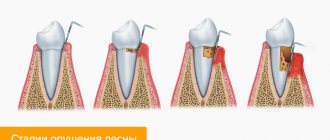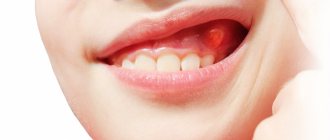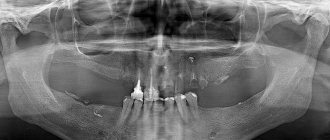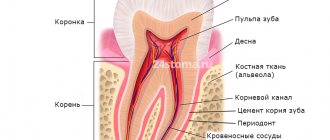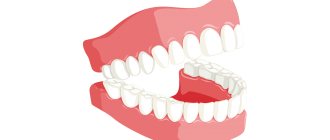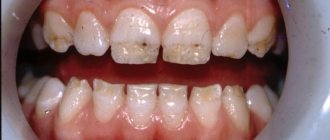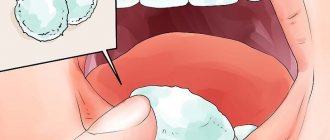Tooth roots inevitably begin to become exposed in old age - this process is completely natural and is a reaction to the aging of the body. But old age is far from the only reason for this phenomenon, which spoils a beautiful smile and can lead to other serious illnesses in the future. Root exposure can occur at any age due to disease or pathology.
This article will talk about what to do in a situation where the gum has noticeably risen above the tooth, and you will also find answers to why this happens and what the consequences of refusing treatment may be.
For what reasons are the roots of teeth exposed?
The phenomenon of exposed teeth in dentistry has a name - gum recession, but usually recession is only a symptom behind which another dental disease is hidden. Most often, it is the lower row of teeth that suffers from recession, since it bears the brunt of the load.
A common disease that causes gums to become exposed is periodontitis, during which inflammatory processes begin to occur in the periodontal tissues; if such a disease is started, it can become chronic.
Typically, periodontitis is a consequence of poor oral hygiene. Plaque and food debris that accumulate between the teeth and on the surface gradually enter the soft tissues and provoke inflammatory processes.
Inflammation significantly weakens the gums, making them weak and unable to maintain their shape. Then they descend and expose the neck of the teeth, which can lead to their loosening and loss. Periodontitis can also be caused by natural pathology.
The second most common cause of exposed roots is periodontal disease, which, unlike periodontitis, is not an inflammatory disease. During such a disease, the gums decrease in size due to atrophy of soft tissues, or disruption of metabolic processes in them.
Other reasons that cause denudation of teeth include:
- Improper brushing of teeth, namely too much pressure of the brush on the gums.
- Tooth decay close to the gums due to caries.
- Malocclusion, short frenulum of the tongue and other pathologies of the oral cavity.
- Malfunctions of the thyroid gland and gastrointestinal tract.
- Caries that has penetrated deep into the dental tissue often causes the gums to detach from the tooth.
To eliminate the defect, it is necessary to find out the cause of its occurrence. If the disease is allowed to progress, the gums will eventually recede to the point where the tooth can fall out. Considering that most of the causes of such a defect are not local, but affect the entire oral cavity, refusal of treatment can lead to the loss of all affected teeth.
Gumplasty
In advanced cases, conservative therapy does not always help. Then doctors have to perform a surgical operation aimed at:
- restoration of a healthy and beautiful gum line;
- elimination of symptoms caused by tissue atrophy;
- preventing the unit from loosening and falling out.
Gingivoplasty is a flap operation. With its help, it is possible to build up missing tissues. The operation is performed in different ways. The most popular is to take a flap of material from the palate and transfer it to the operated area.
But, if the defect is single (that is, it relates to only one tooth), such serious intervention can be avoided. The dental surgeon simply makes two horizontal and two vertical incisions and displaces the resulting flap by transferring it. After regeneration, the operated area begins to look natural and neat.
Remember: folk remedies are not able to restore atrophied gums. Do not delay treatment at the dental clinic. This is the only way to keep your teeth intact.
Associated symptoms
The tooth consists of three parts:
- Crown.
- Neck.
- Root.
In a healthy state, only the crown should be visible, the neck should be covered by the gum, and the root should be located in the alveolus (a special recess for the root). When the process of recession begins, the neck of the tooth is exposed, but that’s not all; along with this problem, the following symptoms usually appear:
- High tooth sensitivity when in contact with extremely cold, hot, sweet, salty and sour foods, because the tooth exposed the sensitive part of the neck, on which there is almost no protective enamel.
- Noticeable darkening of the enamel spoils the appearance; the situation is also aggravated when the neck of the tooth, which is yellow, is exposed.
- Visually, the tooth appears longer.
- Feeling of discomfort in the gums. When you try to press on it with your tongue, it does not fit tightly to the tooth, but moves away from it.
- When brushing your teeth, your gums become very swollen, painful and red.
- Wide interdental gaps appear at the base of the tooth.
It should be noted that any of the above symptoms are more acutely felt in adolescence and middle age, while older people may not notice or feel that anything is wrong. Therein lies a great danger, because adult patients most often come when the situation has reached a critical point and it is almost impossible to save the tooth.
What diagnostics are required?
Treatment can begin only after a thorough diagnosis. During a visual examination, the doctor assesses the degree of exposure of the roots and records the depth and width of the recession. If the loss of soft tissue is significant, the patient must be sent for an x-ray examination, because often with severe periodontal inflammation, the pathological process spreads to the bone tissue and leads to its atrophy.
Why you shouldn’t ignore the problem - what complications this can lead to
First of all, the neck of the tooth is exposed, then always after some time the root is exposed; the disease simply cannot remain at one stage. Due to the weakening of the tissue, the gums become smaller and can no longer cope with the task of holding the tooth, which is why it becomes loose at the slightest pressure.
Before the tooth falls out, deformation of the entire dentition will occur and with a high probability a tooth fracture may occur at the point of contact between the neck and crown, due to the low density of the enamel in this area.
Another almost inevitable consequence of failure to treat gum recession is a wedge-shaped defect, as a result of which the edge of the gum that is adjacent to the tooth takes on a V-shape, which immediately catches the eye and spoils the aesthetic appearance. To prevent complications, it is necessary to consult a dentist in a timely manner, find out the reason why gum recession occurs and eliminate it as soon as possible.
Pain is not the only problem that may bother you
With such a pathology, as we mentioned above, the necks of the teeth hurt. However, if you do not think about what to do in a timely manner, the problem will get worse. For example, a pathology can spread to the entire series and become generalized, then treating it later will be more difficult, and it will take a lot of time. In addition, exposing the hidden parts of the tooth will make your smile unattractive, it will lose its aesthetics, which in turn can cause psychological problems and refusal to communicate with others.
Pain also leads to another problem - you cannot eat what you want and cannot eat properly, which in turn is fraught with gastrointestinal diseases, weight loss and bad mood.
Pain impairs quality of life
The exposed necks of the teeth are defenseless not only against mechanical stress and the temperature and hardness of food, but also against the attack of bacteria. Therefore, if you do not start treatment on time, you may develop caries, pulpitis, and periodontitis.
Treatment Options for Gum Recession
After finding out the main reason that caused such an unpleasant phenomenon, treatment can begin. When treating gum recession, the primary goal is to preserve the tooth and prevent future weakening of the gum tissue.
Receding gums are always a consequence of some disease or pathological process. As for treating the recession symptom, modern medicine can offer several ways to eliminate such an unpleasant defect:
- Professional oral hygiene against plaque and deposits . In this type of cleaning, you need to focus on deposits in the gum pockets. Regularly carrying out such a procedure under the supervision of a dentist is the best way to prevent gum peeling and many other dental diseases.
- Treatment using the Vector device . This device takes teeth cleaning to a new level; the advanced German Vector technology perfectly helps to cope with the removal of tartar and plaque. The device releases ultrasonic waves that are safe for the body, but prevent harmful infusion on deposits in the oral cavity.
- Gum curettage is a procedure that helps to effectively get rid of deposits and plaque, and also, if necessary, normalize the condition of bone tissue. There are 2 options for carrying out this procedure. The first option, “closed curettage,” is recommended for patients whose periodontal pockets are no more than 5 mm deep and inflammatory processes have not yet penetrated deep into the bone. The second option is “open curettage” for pockets with a depth of more than 5 mm. In such a situation, the doctor makes a small incision in the gum, thereby peeling off a small section of it to gain access to the bone tissue and tooth root. Then the doctor carries out an antiseptic treatment; if there is bone atrophy, bone chips are planted to restore its normal state.
- Plasmolifting. This type of lifting involves the direct introduction of special autoplasma into problem areas, which is previously isolated from the patient’s blood. Before the procedure, you need to donate about 15 ml of blood, from which the doctor will separate plasma. Such plasma contains an increased number of platelets and protein. Then this liquid enters the gums through an injection and promotes its restoration.
- Vestibullasty of the gums. This method involves a surgical intervention during which a piece of healthy gum is transplanted to the site of the damaged one. After such treatment, long-term drug therapy is prescribed.
- Treatment with vitamins. In the early stages of gum recession, gum recession can be treated by taking a special set of vitamins and professional cleaning. In such a situation, the patient is usually prescribed vitamins A, D, B9, C. It is their lack that weakens the gums.
In the case when the gum recession is too advanced and the tooth is already clearly loose, it is necessary to undergo a splinting procedure (combining the moving parts of a row into a new group and fixing it in the desired position). For fixation, a thin aramid thread is usually used, which is attached to the back of the row, or a prosthesis with claw-shaped branches is installed under each loose tooth.
It is worth noting that sometimes, when the gums have almost exposed the root, the tooth is very loose and is in poor condition, the best solution is to remove it. In the future, an implant can be installed in its place, which will be indistinguishable from a real tooth. Such an implant is the only option to preserve a beautiful smile and jaw functionality.
How to understand that the dental neck is exposed
The sooner a person notices a pathological condition, the better. In the early stages, it is much easier to correct it. Among the main symptoms:
- Lengthening the surface of the crown of the tooth. The unit begins to look very long, which is most often unnatural.
- Increase in interdental spaces. The teeth are designed in such a way that their width gradually decreases towards the gums. When the gums recede, this property becomes clearly visible. Subjectively, a person may notice that food debris has begun to accumulate between his teeth. He has to floss more often.
- Increased tooth sensitivity. Units begin to react very sharply to temperature changes, sweet, salty, sour and spicy foods.
- Gums often bleed. With atrophy of soft tissues, their condition worsens, the walls become thinner. Any inaccurate movement during hygiene procedures or chewing solid foods causes damage to them, which is manifested by bleeding.
- The appearance of the gums changes. It brightens or turns blue, sags in comparison with healthy surrounding tissues. It often looks swollen and inflamed. May hurt when pressed.
- There is an unpleasant odor from the mouth. When gums atrophy, deep gum pockets often form. They are the optimal place for the accumulation of small food debris and the proliferation of pathogenic microorganisms. It is impossible to clean them with a regular toothbrush. Therefore, no matter how much a person brushes his teeth, he cannot get rid of the fetid odor.
Treatment with traditional medicine
The practical use of traditional medicine advice is allowed only as an additional therapy and only after consultation with a doctor. Here are some proven and effective methods:
- Regular rinsing is necessary to clean and strengthen teeth and gums. The best tincture for rinsing would be a decoction of St. John's wort. To prepare it, you need to grind the dry plant and add water to it in a ratio of 1 to 4, then bring to a boil and leave to infuse for 1 hour. You need to rinse your mouth 2 times a day after basic hygiene procedures.
- Compresses. Using compresses will help reduce pain and start tissue repair processes. An effective compress can be made by mixing sea buckthorn oil and olive oil in a ratio of 1 to 1. Then dip a cotton swab into the resulting solution and apply to the problem area for 5 minutes. After which you need to rinse your mouth with water. This procedure will relieve pain.
- Massage. A good massage improves metabolic processes in the gum tissue, which promotes rapid healing. Before the procedure, you need to wash your hands, and then lightly massage the gums with your fingertips for 1-2 minutes.
Treatment without qualified medical advice may lead to a worsening of the condition. Therefore, when the first signs of recession appear, you should first see a dentist and then take treatment measures.
Types of dental root exposure
In addition, it is x-rays that make it possible to determine the class of recession:
- 1st class: the gums recede slightly, exposing the yellowish necks of the teeth,
- 2nd class: there is a displacement of the edge of the mucosa within 2-4 mm towards the root, the tissues in the area of the interdental septa turn pale,
- 3rd class: the mucous membrane completely exposes the necks of the teeth,
- 4th grade: there is a pronounced loss of mucous and bone tissue, x-rays show its atrophy. The neck along with the root protrudes from under the gum, and the spaces between the teeth become wider and more noticeable.
It is important to determine what exactly caused the recession, and symptomatic therapy can already be prescribed based on the diagnosis. For this reason, independent attempts to cope with the problem do not produce results, and sometimes even provoke complications.
Prevention measures
It is impossible to completely guarantee protection against the gradual separation of the gums from the tooth, because this will happen naturally with age, but you can slow down this process. Experts in the field of periodontology and dentistry have identified several basic recommendations, following which you can minimize the risk of gum recession:
- The first thing you need to do is systematically visit the dentist 2-3 times a year as a preventative measure.
- You need to give up bad habits or reduce them to a minimum.
- Enrich your daily diet with fresh fruits and vegetables.
- Perform hygiene procedures at least 2 times a day, in the morning and before bed. If desired, you can supplement brushing with dental floss.
- If you suspect or have any symptoms of any oral disease, consult a doctor immediately.
Regular dental checkups are something that most people neglect. Therefore, you need to develop a habit that will help keep your teeth healthy.
It is important to know! If your gums are your weak spot, you need to brush your teeth very gently, using a soft toothbrush and mouthwash. A hard brush can harm the gums and cause them to separate over time.
Gum recession is not just an aesthetic problem. This phenomenon signals the presence of a more serious disease or ongoing pathological processes in the soft tissues of the gums. Any deviation from the normal state should alert you and cause a visit to the dentist.
Treatment of generalized moderate and severe periodontitis
Laser gingivotomy - surgical treatment of complex forms of periodontitis
Open and closed curettage of periodontal pockets
Catarrhal and hypertrophic gingivitis symptoms and treatment in adults
Laser gingivectomy in the area of one tooth
The roots of the teeth are exposed - what to do and how to treat them
Content:
- Why do the roots of teeth become exposed?
- How to understand that the dental neck is exposed
- How dangerous is the condition?
- What to do if the necks of your teeth are exposed
- Gumplasty
If the tooth is healthy, the root and neck are tightly covered with gum.
Then the smile looks aesthetically pleasing, and the person is not bothered by any discomfort. But under the influence of a number of unfavorable factors, recession of the gum tissue can occur. If they drop, the neck of the tooth is exposed. As a result, the condition of the dentogingival apparatus worsens. The unit gradually becomes mobile. If appropriate measures are not taken, it will fall out. Dentists treat exposed teeth. A person cannot fix the problem on his own. Therefore, if this condition affects you, be sure to make an appointment with your doctor . Do not try to restore the primary volume of the gums using folk recipes. This will not lead to anything good. In this case, you will miss time, which means the course of the disease will worsen.
If periodontitis or periodontal disease is to blame - only comprehensive treatment
The development of periodontitis is accompanied by the spread of inflammatory processes to periodontal tissue. Periodontal disease leads to a decrease in gum volume and rapid atrophy of the oral mucosa due to degenerative processes rather than inflammatory ones. In its “pure” form, this pathology is extremely rare - in 3-5% of cases. Today, it is more often considered as a complication of an advanced form of periodontitis or a consequence of its long-term treatment against the background of the aggressive course of the pathology itself. In both cases, an integrated approach to treatment is required, and it is better for the patient to immediately prepare for long-term therapy.
The treatment regimen for each patient should be worked out taking into account the individual characteristics of his clinical picture and the stage of development of the disease. Typically, such a course lasts about a year, during which some procedures are carried out once, others in a course of up to 10 visits. The complex may include the following therapeutic and preventive measures:
- diagnostics - computed tomography, tests, microflora culture, etc. diagnostic measures,
- comprehensive hygiene – removal of plaque and hard deposits, polishing and fluoridation of enamel, strengthening of mucosal tissues through the application of special hydrogels and a collagen membrane with extracts of medicinal herbs,
- splinting in case of mobility of some teeth,
- closed curettage (for pocket depths up to 4 mm) and open (for greater depths) in combination with treatment and polishing of the root surface,
- application of periodontal dressings with a pronounced healing effect,
- plasmolifting,
- injection vitamin therapy,
- laser therapy to stimulate the restoration of soft tissue cells,
- the use of medications based on hyaluronic acid to nourish the mucous membrane and stimulate its natural restoration (Revident and Revident+),
- fixation of collagen membranes (Creos from Nobel) and APRF membranes based on the patient’s own blood (an alternative to injection plasma lifting),
- the use of drugs to stimulate the growth of soft tissue (Straumann Emdogain),
- use of bone volume replenishment products (BoneCeramic from Straumann, Bio-Oss)
- training in the correct cleaning technique, selection of individual hygiene products, regular visits to the periodontist for preventive examinations.
Periodontitis is a chronic pathology, which is virtually impossible to cure completely. However, within a year of comprehensive treatment and restoration of gums, acute symptoms can be reliably relieved and stable remission can be achieved. However, you will have to continue to maintain the achieved effect, and for this you need to visit your specialist once every six months and carry out maintenance therapy according to his indications.
Treatment of exposed tooth neck
Before starting the treatment process, it is necessary to determine the cause of the disease - depending on this, recovery methods are selected.
If the cause was tartar, then first of all it is removed, and then the gums are treated.
If the cause was improper oral care, then after a set of gum treatment procedures, the doctor gives detailed recommendations and advice on how to properly care for your teeth.
If the cause was a malocclusion, then with the help of an orthodontist, correction is carried out, and then the gums are restored.
If the cause was the absence of neighboring teeth, then to maintain the normal condition of the gums in the future, prosthetics of the missing teeth is necessary.
The worst option is an incorrigible malocclusion pathology, in which it is impossible to eliminate the root cause. Therefore, to maintain gum health, treatment must be completed on an ongoing basis.
